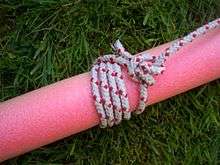Pipe hitch
| Pipe hitch | |
|---|---|
 A pipe hitch, finished with a cow hitch | |
| Names | Pipe hitch, Well-pipe hitch [1] |
| Category | Hitch |
| Related | rolling hitch, klemheist knot, Tensionless hitch, Taut-line hitch |
| Releasing | Non-jamming |
| Typical use | securing a pipe or pole |
| Caveat | The direction of the pulling force should be away from the wrapped coils. |
| ABoK | 504, 2047 |
A pipe hitch is a hitch-type knot used to secure smooth cylindrical objects,[2] such as pipes, poles, beams, or spars. According to The Ashley Book of Knots, "A well-pipe hitch is used to lower a pipe or hoist one."[1]
Information
The pipe hitch will not slip when tied correctly to a pipe or pole. This knot is considered to be similar to and a variation of the rolling hitch knot. It also comes undone quickly and with ease once it is released.[3] This knot can be used with a rope to pull a pipe or spar out of the ground,[4] or to hoist a pipe or beam.
Instructions
The pipe hitch is started by wrapping four or more coils around a pipe or pole. It is normally finished by tying the working end around the standing part with a clove hitch,[3] and less commonly with a cow hitch or a buntline hitch. The pipe hitch can also be finished by crossing the coils and the standing part and tying the working end in one or two half-hitches around the pipe – wrapping in the same direction as the original coils but on the opposite side of the standing part, described in The Ashley Book of Knots as, "another method of tying to a rectangular timber."[5]
See also
References
- 1 2 Ashley, Clifford W. (1993) [1944], The Ashley Book of Knots, New York: Doubleday, p. 82, ISBN 0-385-04025-3
- ↑ "Pipe Hitch". Boy Scouts of America Troup 542 - Gresham Oregon. Retrieved 4 December 2012.
- 1 2 "Another Great Knot: The Pipe Hitch". Survival News Online. Retrieved 2 June 2013.
- ↑ "Pipe Hitch". Troop 542. Retrieved 2 June 2013.
- ↑ Ashley (1944), p.332.